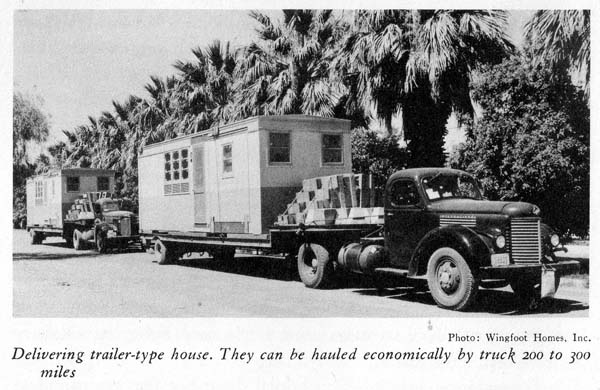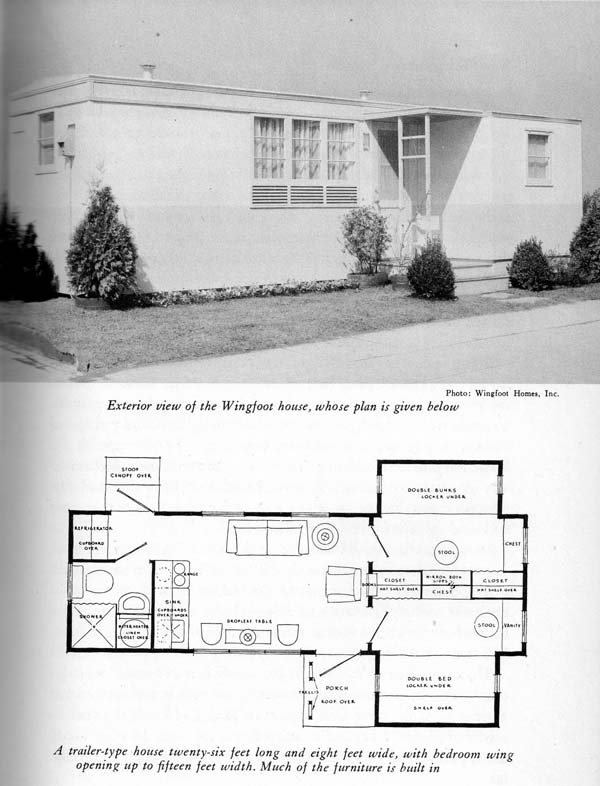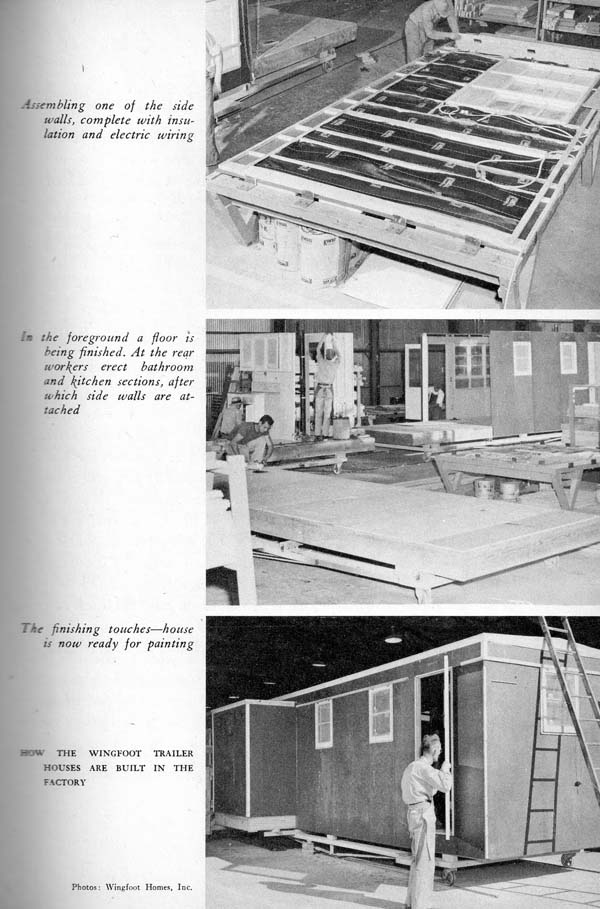Article reproduced from the Instant House Blog
When is a trailer not a trailer?
Answer: when it’s a Wingfoot House! Wingfoot Homes was the brainchild of Goodyear Tire and Rubber Company. Apparently, selling tires wasn’t enough. The world’s best known tire company tried to cash in on the low-cost, post WWII housing boom. The company’s intention was to sell a completely outfitted home (including built-in furniture) for less than $2,000. The idea was that unlike other prefabricated or mass produced housing. The house would be built completely in the factory. Most prefabricators were building components that were later assembled on-site. Wingfoot homes were not designed to go over foundations and were ship completely built – the forerunner of today’s mobile homes.

Getting It There
If you’ve read my previous posts (because you’re my friend, you take pity on me, or both), then you know that shipping is the biggest problem with most prefabricators faced. Shipping a completed house presents a unique problem – the house can’t be more than 8 feet wide! Today’s “Oversize Load” tractor trailers make wider loads possible, but they are quite expensive. Wingfoot decided to avoid this altogether by engineering their house to be 8 feet wide at the time of shipping. Once the house was on site the bedroom sections pulled out “like drawers.” The final house measures 26 X 15 at its widest point when extended. See below for plans.

Wingfoot Popularity
Wingfoot homes were popular out west, where it was difficult to get labor to build a home and where building codes were less strict. Although I cannot find any record of how many Wingfoots were produced or shipped the internet tells me there are enclaves of them in Arizona and southern California.



Shea found this ad and sent it to me, it is neat because it is in color. It would be fun to find a current photo of one of these. I’m sure one is out there somewhere.

I love this! It’layout is very well designed. With a bit of tweaking for modern fixtures it would suit me jut fine. Who knew Goodyear was so innovative when it came to housing?
I really enjoyed the article and have always envisioned building a far more advanced version of such a home. It has to be inexpensive too.
Walt
Would love to know if there are any Wingfoot houses around and still in use….
My interest in tiny homes was first fueled by Bart Cubbins 2nd place winner in a tiny plans contest over at countryplans.com (under 200 sq ft contest). The idea of bump-outs for added space has always struck me as a great idea, especially if trying to keep one’s plans “inside” of land permit regulations.
Love seeing this example that I was not aware of. Thank you!!
Very cool post Kent! Definately an era when Americans didn’t have so much “stuff”… or at least many of them. I really like the old trucking photo of the Wingfoot being moved, which reminded me of a possible post idea. Truckers! Think about it, every long haul truck going up and down the road is a virtual tiny home on wheels. Most are complete with refigerators, microwaves,computers,TV,satalite,a bunk and closets…you name it! Some people may not realize, but many of these drivers live full time in thier trucks or maybe only see “home” a few days a month. When I was driving long haul, my truck was my “tiny” home on wheels and when I was off duty, I lived in my “big” home on wheels (20×8 ft cabin), which seems huge after spending a few weeks out in the rig. Anyhow, I think it would make for a great post. I’d be happy to write something for the TinyHouseBlog on this topic as a guest post, if you and the readers would be interested in such a thing. Thanks Kent, and keep up the fantastic work of the Blog…PEACE!
I suppose that no one is interested the “tiny house trucks” info or history. The ironic thing is that many “green movement” individuals see these trucks as big fossil fuel guzzling tumors in the face of modern ecological ideals. When in fact, the opposite is true. Modern trucks have been way ahead of the the curve in most aspects, in terms of tiny house technology… There are many things which could be and have been adapted from OTR trucks and the drivers thereof, which could serve to broaden the possibilities of the tiny house movement…
Hi Erick, I think that would make a great story please email me at tinyhouseblog (at) gmail.com.
OK Kent,will do. Thanks for keeping an open mind in regaurds to what can be relavent in the tiny house world and how we may all benefit from shared ideals… I’ll start working on something ASAP that hopefully is a worthy contribution to the ongoing dialog here…. Thanks and I’ll keep ya posted!
I think it’s a great idea! Still waiting to see the article though, or did I accidentally pass it up?
I would also love to see that post! We are considering buying a used freightliner trailer as the base of our tiny home. It would be especially helpful to get information about how you hire a trucker to move something like that!
The reason I like tiny house designing is that I think we can do better than trailers. While the wingfoot may have many admirable features, it still makes me cringe.
This was a great article, the ideas could possibly incorporated into today’s tiny house on wheels. Affordable and achievable housing, thanks Kent for all your great posts. Keep up the great work!
I had not seen these before. I’m really impressed with the layout and portability. Would love to see one in person. 😉
Cool article, I did a little searching and found that some of these homes are still standing on South Greenleaf Lane, in Avondale, AZ… You can see them on Google maps satellite view no street view though… some of them have clearly been added on to
This may sound funny but they were shipped more then 200 to 400 miles away. In the mid 70s there were a number of them set-up in and around Birch Bay, Washington. One trailer park rented the four they had. I remember that floor plan, because I almost rented one of them when I was just out of high school and the rent was cheap.
In the mid 80s I ran into a small complex that had few of them in it, they were out by Sea-Tac Airport.
It’s funny to see how far things have come in the last 65 five years… And now some of us think smaller is better… I call a 32 foot 5th wheel home and it’s only 7’9″ wide, it would be nice if this thing was ten feet wide.
Blessings all
Kriss
yeah, I was wondering why slide-outs hadn’t yet been discovered by the tiny home cogniscenti.
Water and heat leakage issues most likely. Fine if you need to slide them out only once cause then you can seal them in place but repeat extending and compacting would have problems and wear.
eh, some people see solutions, some see only problems.
eh, that’s because it is a problem.
I am in the middle of building a tiny house on wheels, 8ft 6 inch by 18 ft. I have bump outs on both ends, the hitch end bump out will hold my kitchen sink and the one on the tail holds the toilet. I wanted to make a slide- out large enough to hold a futon in the couch position on one of the side walls, it makes a lot more day time floor space. On paper it looked great but when it came time to build it I opted for a bump out that will break down in to panels that will be reassembled on site. To build a slide out I would have lost 8 inches of my futon space to the walls that would have to be built to fit inside the opening. If the bump out walls are attached to the out side walls you gain the 8 inches. As we all know a house this size you fight for every usable inch. This makes for a 72 inch futon. Big enough for me to stretch out on, instead of a 64 inch love seat. My house will only be moved once so the tear down and reassembling isn’t that big of a deal.
I’m not a builder by any means but instead of a slide out why not a folding wall that would connect to the outside wall and open in place. Kind of like the wind break pieces on a colman stove.
A pal’s Father built an A Frame in his yard. He hauled up manageable sections to Mtn Land and put it together. Condos by us were put up in 8 ft sections circa 1987. Panelized, built elsewhere, works. For the House, or for add on Rooms that were pre-fit. This older idea is great to read. Thanks.
Looks like a good way to modify a shipping container.
Someone’s selling a photo of the interior on eBay: http://www.ebay.com/itm/Goodyear-Wingfoot-prefabricated-home-1946-/300666340454?pt=Art_Photo_Images&hash=item46011c4466#ht_1641wt_942
Hi Cookie,
Nice photo (of the kitchen)! I sleuthed and discovered that this was a promo photo, and 1 of 3 available for purchase from the Library of Congress! The link to the page with this info (and thumbnails of the 3, but no larger images, sadly) is at:
http://www.loc.gov/pictures/search/?q=LOT%207074&fi=number&op=PHRASE&va=exact&co!=coll&sg=true&st=gallery
Methinks this person on Ebay purchased such a copy from the Library of Congress, and is trying to make a killing selling ‘copies’ (of an ‘original’ they hint at but could not possibly own!). Hmmmh.
I’d much rather have a genuine copy of some brochure, maybe one that was exchanged only between salesmen and such.
Nice read, and I LOVE the layout and bump-out bedrooms. Of course, one would have to completely update the interior to reflect more modern needs and tastes. But a nice ‘little’ house.
Wish I could buy something like this for $2,000 NOW! 😉
The wonders of engineering and design never cease to amaze! That they could fit a house into a space so small and then just fold it out..
What an interesting article! I could live in something like this!
I found a GREAT pic of an old ad for one of these little gems, and it’s color! How can I share it from here, where’s it’s more apt to be shared with others reading this article, Kent?
It’s at:
http://home.mchsi.com/~shear/jipsi/images/Goodyear-WIngfoot-Home-ad.JPG
Hi Shea, please send the photo to tinyhouseblog (at) gmail.com I will post it in the post as the most people will see it that way. -Kent
There was something called the “Plywood Palace” built for post WWII American which was a 1 1/2 story prefab 6 room house. I have never been able to find pictures of it or find out why it failed. Time now requires payment for their archives, although I’m not sure if the original article had pictures. This is all I can find on the internet. May someone who subscribes to Time can find the rest of the story.
http://www.google.com/url?sa=t&rct=j&q=jean%20whiffle%20willis%20plywood%20palace&source=web&cd=2&ved=0CC4QFjAB&url=http%3A%2F%2Ftime-demo.newscred.com%2Farticle%2F1b1db84249de2816df041d2d38b2ca69.html%2Fedit&ei=ZYNJT_TJLcidgQfIudSZDg&usg=AFQjCNF9Q5BABgxNFXKSOt0xBqqVDgA2pQ
My Elementary School had a Bldg moved from an Army Base nearby. Materials were that scarce after WW II. Besides filling a need, Goodyear might have wanted to keep their Workforce busy and producing. Different times back then…
So I finally see my original houses floor plains. I have been told that in 1948 they sold for $4,000 with a 60’ by 130’ plot and all that was need is for you to bring was your clothes and grocery’s. Everyone that has lived in my house has changed it through the years. I have changed it the most by ripping off the roof and adding a second floor. What’s left of the old Wingfoot in my house is in the center of the house and that may not be there for long. Great article and thanks for the pictures it has brought me a lot of joy.
I happen to oum a Wingfoot home serial # 561. the home has don well for the last 65 plus years survining serveral rebuilds and a small addition. Currently the building is in rural Oconto Wisconsin, and serves as summer cottage on Green Bay.Finding the artical was the result of the discovery the homes serial number and building code plackard under many coates of paint in the origional kitchen cabinet during the renovation that took olace this winter.if any one has any more information on the homes please poast them i would very much like any history I can get.
Kent ..loved this…I own 2 single wide mobile homes..bought each new. One 24 yrs ago, for our fish camp and then 3 yrs ago, one for my 90 yr old mom. Had a 18 foot ramp joining them. They survived Katrina with very little damage other than being blown about 4 inches on their cement blocks at one end….That’s it!!!! And that is the 8th direct hurricane the older one has taken.I do live just north of the interstate 10 in Vancleave Ms. We sustained 150mph winds for 10 hours…and my “poor white-trash saltine cans” held their heads high as their expensive brothers and sisters were torn apart!!!! I keep thinking of selling but I am in love with them and am getting ready for a trailer redo on the older one next year. We have spent over $6,000.00 on a flower/shrub planting.
Trailers look as good as the folks taking care of them…..
Carrie
OMG!! I can’t believe I just stumbled across this little house by surfing the web.. My uncle and aunt lived in one of these little house back in the 1950’s on Ellis Place in Canandaigua New York, this house is identical to the one they had rent.. actually there were two of these next to each other that were rented out. Later in the 1960’s the one my uncle and aunt had burned down , and a year later the other one was torn down and a much larger single home was built on that lot.. That was over fifty years ago. I forgotten all about them until now… Dominick,
My family’s first home in Phoenix, Arizona after World War II was a Wingfoot. I remember it well. We originally only had an ice box but later it was replaced. I recall that it was large enough for my parents and me and it had been placed on a reasonably large lot on West Culver and 33rd Avenue. My parents added onto it in the back and it was even more comfortable. The concept was innovative and practical and offered young families after the War the opportunity to have a home of their own.
I imagine RV’S with sliders end up with problems too. I am a grandmother who drove over the road for 22 1/2 yrs and yes, I lived in my truck and it was cool, [except when my truck was in the shop]…I have been in construction 18 yrs now and retired this last yr. to driving my own truck….Have property in Co. and am going back next yr. to start over again and tiny homes appeal to me a lot….this Wingfoot would be perfect, I don’t climb ladders a lot these day’s…as for buying a dry van to make a home of I bought a 40′ for 200 dollars and it has elect. and wood floors, I use it for storage for my move…have thought of making a “Tiny Diner” out of it after it’s empty. Have a wonderful day and live your dreams.
OMG!! What memories I have of this exact little house. Growing up in Canandaigua New York in the 1950’s. My Aunt and Uncle rented and lived in a model like this on dead end street called Ellis Place. There were 2 of these little houses right across from each other. and were parked on a foundation with a small basement under them.. Now at the age 0f 64 I totally forgotten about these little houses.. ( which since have been removed) And have wonder the history of how they can to be… Now I know .. thanks for the memories and information..
This is amazing! I just found photos of the Wingfoot I lived in while going to ASU in 1972.
It was one of several in a nice court yard. The Wingfoot was a great little place to live, just big enough to not be crunched, with all I needed very handy. I do remember there was a goose that also lived in the courtyard. He was a great watch dog!